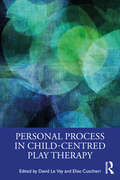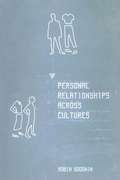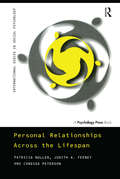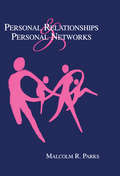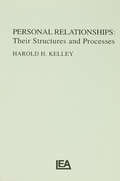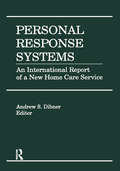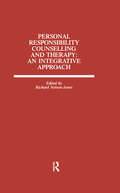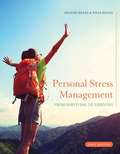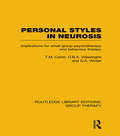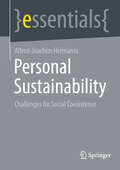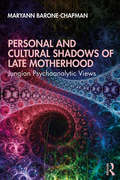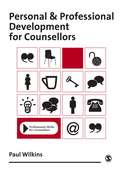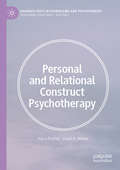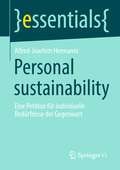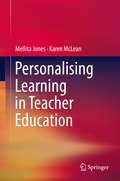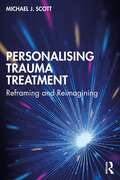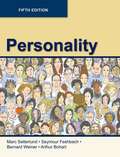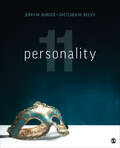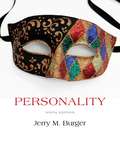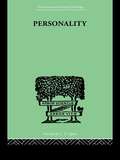- Table View
- List View
Personal Process in Child-Centred Play Therapy
by David Le Vay Elise CuschieriPersonal Process in Child-Centred Play Therapy provides a very specific exploration of the play therapy process from the personal perspective of the play therapist. This volume examines the personal challenges, opportunities, losses and gains, and numerous obstacles that one has to negotiate through the course of both training to become a play therapist and working as a qualified clinician with children who have complex life difficulties. The book aims to offer a forum within which the role, function and process of the "personal" within play therapy can be explored. Bringing together a number of experienced play therapists, the book shares often deeply personal accounts of their experience of training and clinical practice. Chapters challenge the unspoken therapist taboos of shame, childhood trauma, vulnerability and grief, shining a light on the more hidden areas of therapist experience. Clinical issues around the unconscious process are also explored, but once again from the personal position of the play therapist, rather than the child. With a unique and distinct perspective on the therapeutic process, this book is specifically intended for both trainee and experienced play therapists, but will be relevant to all psychotherapists involved in working therapeutically with children and young people.
Personal Project Pursuit: Goals, Action, and Human Flourishing
by Brian R. Little Susan D. Phillips Katariina Salmela-AroPersonal Project Pursuit is the first book to feature Brian Little's highly respected personal projects analysis (PPA), one of the pioneering theories in contemporary personality and motivational psychology. The book examines both the internal and external dynamics of personal goals and projects and clearly demonstrates that human flourishing is enhanced when individuals are engaged in the pursuit of personal projects. The book opens with the theory and methodologies of personal projects research. The historical perspective on the development of the two dominant research perspectives from personality and developmental psychology is explored. Section II examines the internal dynamics and competing demands of goal formulation and project inception. The third part accentuates the role that social ecologies play in shaping the nature and outcomes of personal projects. These chapters highlight the importance of interpersonal relationships, organizational contexts, and the societal and cultural expectations in affecting the pursuit of personal projects. Ideas for orchestrating the environment to enhance human flourishing are explored. Section IV demonstrates how personal projects can illuminate and enhance human flourishing, from psychological well being to physical health. The book concludes with applications for enhancing human flourishing from individual counseling to public policy. Personal Project Pursuit is intended for advanced students, researchers, and practitioners in personality, social, developmental, industrial/organizational, health, environmental, clinical and counseling psychology interested in motivation and well being. An excellent supplemental text for courses on personality, motivation, positive psychology, well being, personal and life span development, the book's applied focus will appeal to counselors and rehabilitation/occupational therapists.
Personal Relationships Across Cultures
by Robin GoodwinIs falling in love the same the world over? What makes a 'happy marriage' in different cultures? How does our society influence us in the way we raise our children? Is modern life incompatible with intimacy? In this innovative new text, Robin Goodwin challenges many of the established views on relationships by considering how different cultures view different relationships (love, marriage, friendship, the family, sexual relations). By discussing fundamental differences in values between cultures, alongside other key influences such as social class and education, he explores why these differences occur, and how different political and historical events have challenged existing patterns of relationships. Finally, drawing on research from all parts of the world, he considers how we can use this knowledge to help different communities across the globe cope with their most pressing relational challenges. Dr Robin Goodwin is Reader in Psychology in the Department of Human Sciences at Brunel University, London. He publishes widely on relationships and culture, and lectures about his work across the world.
Personal Relationships Across the Lifespan (International Series in Social Psychology)
by Patricia Noller Judith Feeney Candida PetersonPersonal Relationships Across the Lifespan presents a comprehensive and up-to-date account of the role of personal relationships in people's lives.Highlighting areas of special significance and research interest at each major life-stage, Patricia Noller, Judith A. Feeney and Candida Peterson, examine how close relationships develop over time and influence individual adjustment. They explore a wide range of relationships, including some that are often neglected, such as those with siblings, adult children and elderly parents. They also look at alternative family forms, such as single-parent families and step-families, and address important themes such as intimacy, conflict and power.With insightful discussion of the theory and methods typically used by researchers working in this area, Personal Relationships Across the Lifespan is an ideal resource for students and researchers of both relationships and lifespan development. It will also be of interest to practitioners, such as social workers and family therapists, working with clients with relational concerns and anyone wanting to learn more about the nature of relationships.
Personal Relationships and Personal Networks (LEA's Series on Personal Relationships)
by Malcolm R. ParksThe effort to understand personal relationships has traditionally focused on the individual characteristics of participants. Personal Relationships and Personal Networks takes this analysis a step further, focusing on research linking participants' feelings and actions within a given personal relationship to the larger social context surrounding it. Author Malcolm R. Parks expands on the idea that the initiation, development, maintenance, and dissolution of relationships are inextricably connected to each participant's social network-a perspective that allows for a better appreciation of our connection to the world, and a greater understanding our significant power as social actors. This book offers a new way to consider basic notions about how relationships form, such as how particular people meet, and how relationships are started. Among many findings, the volume demonstrates that individuals in relationships feel closer and generally more connected when they also have a greater amount of contact with the members of each other's personal networks and when they believe that network members support their relationship. Additional topics discussed include how this social context model is applicable to different types of relationships; how participants interact with network members; how social networks are involved in the deterioration of personal relationships; and what drives change in relationships. Students, researchers, and professionals in a wide variety of disciplines such as communication, psychology, sociology, anthropology, family studies, clinical psychology, public health nursing, education, and social work will find this book useful, as will anyone seeking to better understand their own personal relationships.
Personal Relationships: The Effect on Employee Attitudes, Behavior, and Well-being (SIOP Organizational Frontiers Series)
by Tammy D. Allen Lillian Turner de Tormes EbyWe know that positive, fulfilling and satisfying relationships are strong predictors of life satisfaction, psychological health, and physical well-being. This edited volume uses research and theory on the need to belong as a foundation to explore various types of relationships, with an emphasis on the influence of these relationships on employee attitudes, behaviors and well-being. The book considers a wide range of relationships that may affect work attitudes, specifically, supervisory, co-worker, team, customer and non-work relationships. The study of relationships spans many sub-areas within I/O Psychology and Social Psychology, including leadership, supervision, mentoring, work-related social support, work teams, bullying/interpersonal deviance and the work/non work interface.
Personal Relationships: Their Structures and Processes (Distinguished Lecture Series)
by Harold H. KelleyFirst published in 1982. Routledge is an imprint of Taylor & Francis, an informa company.
Personal Response Systems: An International Report of a New Home Care Service
by Andrew S DibnerThis important new book describes the origins, developments, and current status of personal response systems, a new means for persons at risk who live alone to get help in case of emergency. In Personal Response Systems, experts from ten countries report on the status, achievements, and challenges involved in setting up, distributing, and operating personal response systems (PRS). Experienced authors from a variety of backgrounds describe the technology, economics, and social effects of PRS, and its integration into existing health and housing programs. Professionals who provide home health services will find important information about the most efficient and cost effective designs of personal response systems. They will learn how to evaluate and recommend the most appropriate systems for their clients with the assistance of this valuable new book. Research on the frequency and types of emergencies and the many psychological and social benefits to users of this new technology and their families are also discussed. Personal Response Systems covers systems in a number of countries, including Japan, Israel, Sweden, New Zealand, and Germany. Authors representing universities, social agencies, and manufacturing plants provide a balanced, thorough presentation of the subject. These authors discuss: the technology of personal response systems demographic trends how to set up a PRS in a community the integration of PRS into housing for the elderly and disabled benefits to consumers and health care systems the effects of PRS on family relationships emergencies best suited for PRS analysis of how future technology will expand the medical and protective functions of PRSHealth care planners, social workers, physicians, case managers, housing developers and managers, and others involved in caring for the elderly or disabled will find a valuable store of information in this comprehensive volume. They will be able to evaluate more quickly the most appropriate PRS services for their clients and tenants.
Personal Responsibility Counselling And Therapy: An Integrative Approach
by Richard Nelson-JonesFirst Published in 1988. All counselling approaches are means to helping people stand on their own two feet and assume effective responsibility for their lives. Thus personal responsibility becomes an obvious integrating focus. Though the concept gets implicitly or explicitly emphasized in all existing theoretical positions, none has provided the deserved coverage. Focusing on personal responsibility is almost like focusing on one’s nose. Though right in front of the face, the concept is not always easy to observe. This book aims at integration in a number of ways. It rejects the narrow ‘my theory right or wrong’ approach to counselling. Theoretical concepts and practical interventions are derived from a number of different sources, including the research literature. The book does not take a one-dimensional approach to behaviour in emphasizing people’s actions alone. Instead it takes a three-dimensional approach emphasizing feelings, thoughts and actions.
Personal Stress Management: From Surviving to Thriving
by Dianne Hales Julia HalesThis book equips you with the insights and skills you need to conquer the demands ahead, and give you relief when stress levels rise. Written by health and psychology experts, this book delivers specific strategies for tackling common campus stressors, including academics, time management, and relationship issues. You’ll learn helpful, easy strategies for changing your perspective and responding to stress with confidence and resilience, empowering you to manage even the most difficult situations and come out on top--in the classroom, in the workplace, and in life. This book engages you with practical tools you can use immediately, incorporating the latest insights from neuroscience, exercise physiology, nutrition, and medicine, while highlighting healthy habits like regular exercise and good nutrition to prevent burnout.
Personal Styles in Neurosis: Implications for Small Group Psychotherapy and Behaviour Therapy (Routledge Library Editions: Group Therapy)
by T.M. Caine O.B.A. Wijesinghe D.A. WinterOriginally published in 1981, the inadequacies of the ‘medical model’ for the understanding and psychological treatment of neuroses were widely recognized. A number of alternative approaches had arisen in response, but most of the models were theoretical, and little experimental support was documented. One of the most pressing needs at the time was for a system of classification which could predict the behaviour of different types of neurotic patient under different treatments, and thus provide a framework for the selection of patients for small group psychotherapy and for behaviour therapy. The authors of this title develop such a framework, involving the matching of patient, therapist and treatment according to certain adjustment strategies such as ‘direction of interest’, ‘conservatism’, ‘convergent-divergent thinking’, ‘openness to inner experience’ and ‘control’. The ‘personal style’ of an individual is defined by these strategies, and by the patient’s expectations from treatment. The authors collected a considerable amount of original research material over many years, and their evidence demonstrates the fundamental importance of ‘personal style’ in treatment allocation and response. The new approach which they propose will be of interest not only to academic psychologists but to those in the mental health professions actively engaged in psychotherapy and behaviour therapy.
Personal Sustainability: Challenges for Social Coexistence (essentials)
by Alfred-Joachim HermanniHuman existence is often treated only theoretically in discussions about sustainability — as if the individual, with their unique needs and characteristics, plays only a minor role in the implementation of the United Nations&’ Sustainable Development Goals (SDGs). To generate broad interest in the UN&’s sustainability agenda among the general population, it is essential to incorporate the needs of the largest social groups into the agenda and enable their participation in achieving the SDGs. This essential explores the new dimension of &“Personal Sustainable&”, along with the opportunities and challenges it presents.
Personal Therapy: How to Change Your Life for the Better
by Dr Brian RoetUnresolved and unconscious trauma and distress can cause depression and other psychological states, but how can therapy help? How does it work? What sort of techniques are employed? In PERSONAL THERAPY Dr Brian Roet explains how therapeutic techniques can be used to release deep-seated emotions, to acknowledge our strengths and weaknesses, and help establish emotional equilibrium. His reassuring and practical advice explains how therapy can lead to enjoying a more fulfilling life.
Personal Transformations in Small Groups: A Jungian Perspective (The International Library of Group Psychotherapy and Group Process)
by Robert D. BoydFirst published in 1994. Routledge is an imprint of Taylor & Francis, an informa company.
Personal and Cultural Shadows of Late Motherhood: Jungian Psychoanalytic Views
by Maryann Barone-ChapmanPersonal and Cultural Shadows of Late Motherhood explores the topic of delayed motherhood from a Jungian psychoanalytic perspective, using both quantitative and qualitative research methods, including interview transcripts, diaries, dreams, and Jung's world renowned Word Association Experiment. It provides a unique contribution to our understanding of the pressures faced by women today on the topic of delayed motherhood. We may consider an affect to be in place when a woman allows her relationship to her body and its procreative capacity to slip away from consciousness, only to awaken at a point when redeeming her past choices becomes a hunger. This book delves into personal, cultural and collective spheres of influence that have been split off waiting for the right moment to reintegrate. Working with Interpretive Phenomenological Analysis and Jung’s Word Association Experiment, the author identifies aspects of the psyche arousing late procreative desire and considers the differing accounts of maternal and paternal parents, within affective experience of growing up female beside a male sibling. The book examines women’s procreative identity in midlife, identifies complexes of a personal, cultural and collective nature and considers how the role of mother is psychosocially performed, taking in feminist psychoanalytical thinking as well as Queer theory to explore new meanings for late motherhood. This book will be of great interest to clinicians, researchers, academics, postgraduate students of Jungian psychoanalysis, gender theory, psychosocial studies, and those travelling alongside a woman's journey into later motherhood.
Personal and Professional Development for Counsellors (Professional Skills for Counsellors Series #4)
by Paul Wilkins`A helpful guide for newly qualified counsellors. It gives some comprehensive ideas and tips for further development... a useful book' - Self & Society
Personal and Relational Construct Psychotherapy (Palgrave Texts in Counselling and Psychotherapy)
by David A. Winter Harry ProcterThis book introduces Personal and Relational Construct Psychotherapy, a development by the authors of an approach to psychotherapy originated in the 1950’s by George A. Kelly. Drawing on a lifetime of experience in working with people in mental health settings, Procter and Winter focus on the crucial relationships that form the context of human struggles, and how these can be a fertile resource in problem-resolution. The book provides step-by-step descriptions of assessment and therapeutic methods for working with individuals, families, and groups, as well as exploring the philosophical background of the approach, its application to formulation, supervision, and reflective practice, its relationships to other models of psychotherapy, and its evidence base. The book will be invaluable for psychotherapists, counsellors, and psychologists of all levels and traditions, and useful for students and trainees in health, education, social work, and any field involving helping people with the difficulties of everyday life.
Personal sustainability: Eine Petition für individuelle Bedürfnisse der Gegenwart (essentials)
by Alfred-Joachim HermanniDie menschliche Existenz wird bei Nachhaltigkeitsfragen meist nur theoretisch abgehandelt, als würde der Mensch als Einzelwesen mit seinen Ansprüchen und Besonderheiten eine untergeordnete Rolle bei der Umsetzung der Nachhaltigkeitsziele der Vereinten Nationen spielen. Um auf ein breites Interesse für die UN-Nachhaltigkeitsziele bei der Mehrheitsgesellschaft zu stoßen, ist es erforderlich, gerade auch die Bedarfe der größten sozialen Bevölkerungsschichten in die Agenda einzubinden und an den Sustainable Development Goals partizipieren zu lassen. Dieses essential setzt sich mit der neuen Dimension „Personal Sustainable“ und den damit verbundenen Chancen und Herausforderungen auseinander.
Personalising Learning in Teacher Education
by Mellita Jones Karen McLeanThis volume sheds light on debates about personalised learning in teacher education by exploring the popular emergence of personalising learning in education and hence its significance in teacher education in the 21st century. It examines personalising learning theory and explores the tenets of this theory and its recent trends in international settings. The theory is explored in relation to both general and higher education pedagogy, and in a range of examples within a teacher education context. The examples from practice provide insights into maximising the potential for personalising learning theory to enhance teaching, learning and assessment in teacher education. The book includes case studies involving pre-service teachers working in communities of practice with one another, with schools and with the wider community. Examples of technology for personalising learning are also described. All the case studies demonstrate how the learner is made central to the teaching and assessment approaches adopted and contributes to a lifelong learning continuum. Providing insights into a new pedagogy for teacher education that leads to an enriched student experience, the book presents a model for personalising learning in teacher education that offers support for 21st century teacher educators.
Personalising Trauma Treatment: Reframing and Reimagining
by Michael J ScottPersonalising Trauma Treatment is about helping trauma victims back to their old selves and focuses on altering the perception of the centrality of the trauma. In this book, clients are taught to rediscover their sense of self by reframing the trauma. Within this new framework the focus is on the client’s mental time travel from the trauma to today and reimagining their future. The therapeutic targets are the thoughts and images (cognitions) that interfere with day-to-day functioning. It does not assume that arrested information processing lies at the heart of the development of PTSD, with a consequent need for the client to re-live the trauma. For those clients who were abused in childhood, their experiences are viewed through a particular central window, but other ‘windows’ may make for more appropriate engagement with their personal world and a reimagining of their view of themselves. Treatment delivery options from telephone consultation, group work and videoconferencing are discussed. With illustrative examples, the author highlights the pathway to recovery for a wide range of clients with the comorbidity often found in real-world settings. The book will be essential reading for therapists and other mental health professionals working with trauma survivors.
Personality
by Arthur Bohart Bernard Weiner Seymour Feshbach Marc SetterlundPersonality, 5E,is a student friendly and accessible text for undergraduates at two and four-year colleges, assuming no background in psychology. This eclectic, empirical, and comprehensive text covers classic topics such as learning, the humanistic and the psychoanalytic approaches, as well as a fresh examination of topics such as traits, genetics, culture, and the self. This text explores the influence of identity, development, nature, and nurture on personality. The text discusses personality in the context of emotion, stress, love, and aggression. The authors compare major theories of personality, and discuss personality processes and dynamics.
Personality
by Jerry M. Burger Gretchen M. ReevyNow published by SAGE! In Personality, the historical underpinnings of core theories and research come alive through biographical and contextual illustrations. Author Jerry M. Burger, and new co-author Gretchen M. Reevy, use vivid stories and discussions to challenge learners to critically consider the discipline’s approach to diversity, research science, and its future as a holistic field of study. With a balance of both theory and research, along with application sections and personality tests, students gain hands-on experience and a comprehensive understanding of the subject matter. Every chapter in this Eleventh Edition has been thoroughly updated, such as sections on Extraversion-Introversion, Dream Interpretation, and Gender Roles, to reflect the most recent research. It also features 400 new references, a new research topic on Narcissism, and two new personality scales. This title is accompanied by a complete teaching and learning package. Contact your SAGE representative to request a demo. Digital Option / Courseware SAGE Vantage is an intuitive digital platform that delivers this text’s content and course materials in a learning experience that offers auto-graded assignments and interactive multimedia tools, all carefully designed to ignite student engagement and drive critical thinking. Built with you and your students in mind, it offers simple course set-up and enables students to better prepare for class. Learn more. LMS Cartridge: Import this title’s instructor resources into your school’s learning management system (LMS) and save time. Don’t use an LMS? You can still access all of the same online resources for this title via the password-protected Instructor Resource Site. Learn more.
Personality
by Jerry M. Burger Gretchen M. ReevyNow published by SAGE! In Personality, the historical underpinnings of core theories and research come alive through biographical and contextual illustrations. Author Jerry M. Burger, and new co-author Gretchen M. Reevy, use vivid stories and discussions to challenge learners to critically consider the discipline’s approach to diversity, research science, and its future as a holistic field of study. With a balance of both theory and research, along with application sections and personality tests, students gain hands-on experience and a comprehensive understanding of the subject matter. Every chapter in this Eleventh Edition has been thoroughly updated, such as sections on Extraversion-Introversion, Dream Interpretation, and Gender Roles, to reflect the most recent research. It also features 400 new references, a new research topic on Narcissism, and two new personality scales. This title is accompanied by a complete teaching and learning package. Contact your SAGE representative to request a demo. Digital Option / Courseware SAGE Vantage is an intuitive digital platform that delivers this text’s content and course materials in a learning experience that offers auto-graded assignments and interactive multimedia tools, all carefully designed to ignite student engagement and drive critical thinking. Built with you and your students in mind, it offers simple course set-up and enables students to better prepare for class. Learn more. LMS Cartridge: Import this title’s instructor resources into your school’s learning management system (LMS) and save time. Don’t use an LMS? You can still access all of the same online resources for this title via the password-protected Instructor Resource Site. Learn more.
Personality
by Jerry M. BurgerThis proven text fuses the best of theory-based and research-based instruction to give readers an illuminating introduction to personality that is accessible and understandable. The author pairs "theory, application, and assessment" chapters with chapters that describe the research programs aligned with every major theoretical approach. Biographical sketches of theorists and accounts of the stories behind influential research programs help readers gain an understanding of how classic and contemporary findings relate to each other, and reinforce the idea that theory and research perpetuate one another. In-text self-assessments encourage readers to interact with the material and allow them to learn more about their own personality.
Personality (International Library Of Psychology Ser.)
by R G GordonFirst Published in 1999. Routledge is an imprint of Taylor & Francis, an informa company.
